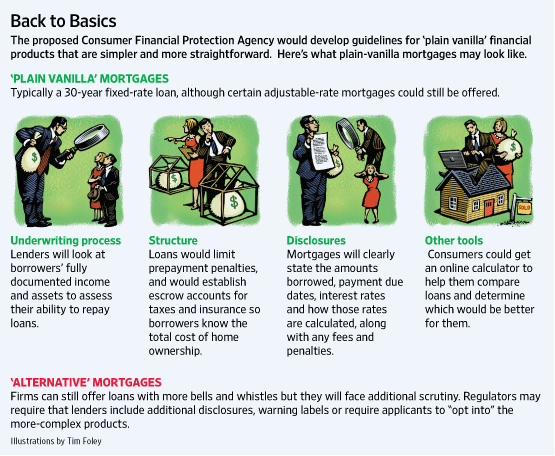Plain-Vanilla Mortgages as a Solution to Mortgage Crisis
One of the cornerstones of the Obama administration’s plan to overhaul the US mortgage system is an emphasis on so-called “plain-vanilla” financing. Specifically, “The government would give its seal of approval to a handful of mortgage types — a standard 30-year fixed-rate mortgage and perhaps a few varieties of adjustable-rate loans. For a loan to get the ‘vanilla’ label, the lender would have to verify borrowers’ income and have them set aside money for property tax and insurance.” A 20% down-payment would be required, prepayment penalties would be eliminated, and all fees/costs would have to be clearly stated. [See chart below, courtesy of WSJ].

The primary purpose of the plain-vanilla system would be to protect borrowers, many of whom were burned by complicated mortgages during the height of the housing boom. Types of mortgages have exploded both in number and complexity, such that there are now hundreds of different variations, requiring various levels of risk disclosure and creditworthiness. Ostensibly, this innovation was designed to help consumers by giving them more choices. Human nature being what it is, many borrowers opted for the riskiest mortgages. Meanwhile, banking profits soared. Given how opposed the banks are to the return to plain-vanilla lending practices, it’s pretty obvious as to who is benefiting most from the current system.
There is a strong political bend to this regulation, given the assumptions about human nature that it makes. Still, there is something to be said for simplicity. A fixed-rate mortgage is predictable and easy to understand. Income verification confirms the borrower’s ability to afford the mortgage, and a large down-payment lowers the possibility of default. Sure there are borrowers who liked the freedom to use their mortgage to make a bet on the direction of interest rates, and/or who successfully exploited liar’s loans to purchase a house they otherwise wouldn’t have received lending approval for. But for everyone who came out ahead with a zero down payment ARM, anecdotal evidence suggests that there are 9 who came out behind and are now in default.
Under the new system, those who want to play roulette with their home/finances can still do so, but will be strongly discouraged in the form of un-preferential treatment/pricing. “According to the administration’s ‘white paper’ on the proposal, the agency ‘could impose a strong warning label on all alternative products; require providers to have applicants fill out financial experience questionnaires; or require providers to obtain the applicant’s written ‘opt-in’ to such products.’ ” In this way, banks will also be protected, since consumers can no longer pretend that they weren’t aware of the risks when they signed up for the mortgage.
In the wake of the housing crisis, risk aversion has increased, and it looks like banks/consumers are actually one step ahead of the government. “With the housing bubble burst and mortgage rates near historic lows, fixed-rate loans — 30-year, 15-year and other types — now account for about 95 percent of the market,” compared to only 50% during the height of the boom in 2004. But people have short memories. If this regulation passes, it will make it more difficult for people to overextend themselves when the economy begins to recover.
El Monte Homeowners May Want to Refinance While Rates Are Low
US 10-year Treasury rates have recently fallen to all-time record lows due to the spread of coronavirus driving a risk off sentiment, with other financial rates falling in tandem. Homeowners who buy or refinance at today's low rates may benefit from recent rate volatility.
The following table shows current 30-year mortgage refinance rates available in El Monte. You can use the menus to select other loan durations, alter the loan amount. or change your location.
Leave a Reply

Free Mortgage Calculator for Your Website!
Would your customers benefit from a free mortgage calculator on your website? Learn how to add a calculator to your website in less than a minute - FREE!


